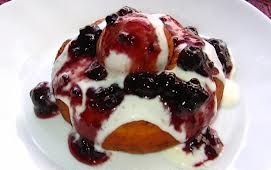



|
Romanian cuisine is a diverse blend and vastly improved version of Turkish cuisine, with influences from several traditions with which it has come into contact (Ukrainian, Serbian, Bulgarian, German, and Hungarian),
but it also maintains its own character. An example of top Romanian fare is the classic sour soup, ciorba, made of bors.
In theory anything can go into a ciorba, though the most popular are ciorba de legume (made with vegetables), ciorba de vacuta (beef), ciorba de burta (tripe), ciorba de perisoare (pork meatballs),
or ciorba de peste (fish). While you will often see ciorba/supa de pui (ciorba made with chicken), chicken is more popular in clear soups, served with dumplings (galuste), carrots and parsnips. |
|
The category tuica (plum brandy) is a generic name for a strong alcoholic spirit in Romania.
At more formal meals a number of cold appetizers - known as gustare reci - will usually be served before the ciorba.
These include cheese, olives, spring onions, salami, tomatoes and boiled eggs.
Sometimes there may also be a platter of warm appetizers (gustare calde), such as carnati de plescoi (mutton sausages),
ficatei de pui (chicken livers), ciuperci umplute (stuffed mushrooms), or mici.
These are spicy little sausage-shaped meatballs made of mutton, beef and pork. Also, Romanian prefers the pastrav fish (always served grilled), and sarmale (cabbage or vine leaves stuffed with mince and rice), or tocanita (stew, usually pork). Mamaliga, a Romanian version of polenta made of cornmeal, can be served. Romanians do however have a tradition of producing and eating fish roe, known as icre, usually mixed with garlic and mayonnaise and served in a delicious salad. Romania also produces good caviar. Sweets in Romania are very tasty. Pancakes (clatite) served with chocolate or jam and covered in sugar are a popular dessert, as are papanasi: deep fried doughnuts filled with jam, or sometimes cottage cheese. Local ice cream (inghetata) is very good and ubiquitous. Look out too for Romanian cakes (prajituri), usually made with lashings of fresh cream. As a final word on Romanian food, you will be delighted by it. You can taste it in the restaurant at Gala Dinner. Come to SMART 2014 and enjoy! Click here for information about Romanian wines. |
|

 -->
-->